Steel structures production
We manufacture steel structures up to execution class EXC3 according to ČSN EN 1090.
We supply structures not only to the Czech market but also abroad. Our many years of experience and production capacity allow us to produce large and technically demanding structures that meet customer specifications. We regularly pass supplier audits from companies such as Metrostav and Österreichische Bundesbahnen.
We supply structural units for:
civil engineering
- steel halls
- noise barriers
- crane tracks
- truss beams
- supporting and service platforms
engineering
- casting molds for concrete
- machine frames
- belt conveyors
- technological tanks
energy industry
- HV and EHV poles
- substation beams
- substation towers

Advantages of Abadia structures

Quality control
Thanks to our experience with projects in the engineering and technological industries, we deliver welded structures and final products in compliance with the required manufacturing tolerances. We perform visual, penetrant, magnetic particle, ultrasonic, and X-ray tests.
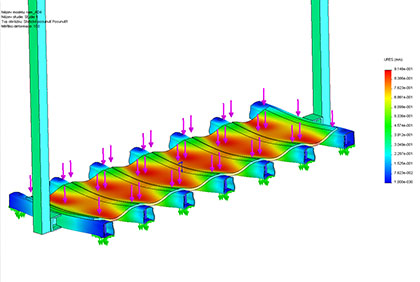
Steel structure design
We have a certified design and engineering process for steel structures, allowing us to deliver both manufacturing documentation and production. Our structural engineers use 3D modeling to prepare documentation.
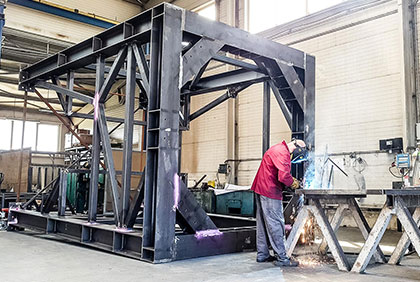
Space for large projects
Our production facilities include two halls with a total area of over 4,000 m². The main production hall is equipped with overhead cranes with a load capacity of 6.3 and 5 tons. The maximum size of a single weldment is 20 meters in length and 6 meters in height. The production capacity for heavy steel structures is up to 100 tons per month.
Steel structure production process
Material preparation
The surface of carbon steels is shot blasted in a modern continuous blasting machine before processing. The material is then cut on two cutting centers with a maximum diameter of 600 mm. Preparation continues on press brakes and punching machines.
Continuous blasting machine at Abadia
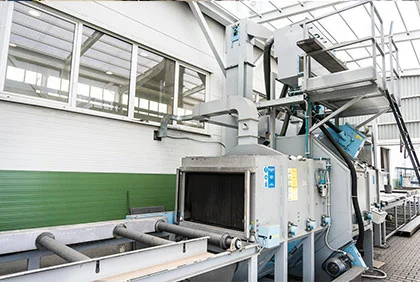
Plasma cutting center at Abadia
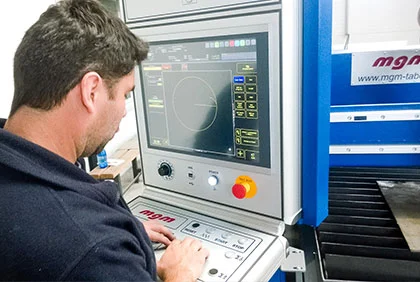
Sheet metal blanks
Complex shapes are produced at our plasma cutting center with a Hypertherm source. We can cut carbon steel up to 34 mm thick and stainless steel up to 18 mm. For thicker materials, we cooperate with proven partners.
Material welding
Welding is carried out by welding personnel certified according to ČSN EN ISO 9606-1. The welding process is certified according to ČSN EN ISO 3834-2 and is supervised by an internal welding engineer. Welding is performed according to approved WPQR or WPS for methods 131, 135, 141, and 111 for both carbon and stainless steels.
Welding of carbon steel at Abadia
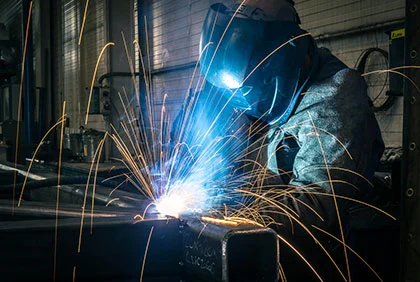
Ultrasonic testing at Abadia
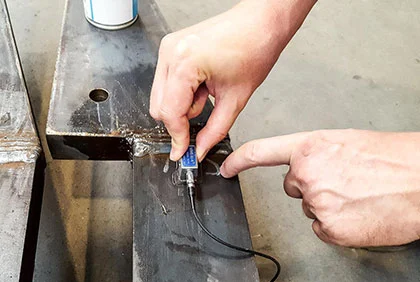
Inspections and testing
Abadia has an established certified inspection and testing system, supervised by an internal quality manager authorized according to ČSN EN ISO 9712.
Quality testing is conducted according to the approved inspection plan and includes dimensional checks at various stages of production, visual and penetrant weld inspections. Where necessary, they are supplemented by ultrasonic testing, magnetic particle testing, or X-ray testing.
Surface treatments
Products are treated with various surface treatments. Our company has its own "wet" paint shop. A large part of the production is hot-dip galvanized. This process is provided by our long-term partner, Wiegel. Other surface treatment options include metalizing or powder coating.
Hot-dip galvanizing at Wiegel

High-capacity crane at Abadia
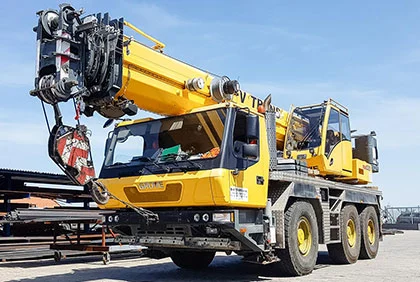
Delivery to the customer
Our products are delivered literally worldwide. We own two trucks with a capacity of up to 7.5 tons, and together with our partners, we can arrange transportation beyond this limit. For the delivery of products to other continents, we use sea container shipping.
The difference between EXC2 and EXC3
EN 1090 is a European standard related to the manufacturing and control of steel and aluminum structures. This standard is divided into three parts: EN 1090-1 (requirements for conformity assessment), EN 1090-2 (technical requirements for steel structures), and EN 1090-3 (technical requirements for aluminum structures). In EN 1090-2 and EN 1090-3, structures are classified into four execution classes (EXC): EXC1, EXC2, EXC3, and EXC4. These classes reflect the complexity, dimensions, and load of the structure, as well as the level of quality control and production supervision.
The differences between EXC2 and EXC3 are as follows:
- Complexity and application of the structure: EXC2 includes structures with moderate risk and medium complexity, such as residential and commercial buildings, industrial facilities, and pedestrian bridges. EXC3 involves structures with higher complexity and higher risk, such as bridges, towers, poles, and other structures with high loads or special stability requirements.
- Project responsibility: EXC2 requires the project to be carried out under the supervision of a responsible engineer with an appropriate level of experience and expertise. For EXC3, the project must be carried out under the supervision of an experienced engineer specializing in construction, with deep knowledge and experience in structural requirements and execution methods.
- Quality control and supervision: EXC3 requires a higher level of quality control and supervision during production than EXC2. This includes more inspections, tests, and verification of compliance with welding, assembly, surface treatment, and other aspects of the structure's production.
- Welding and welding personnel: For EXC3, the requirements for welding and the qualification of welding personnel are stricter than for EXC2. For example, welding procedures must be more carefully documented and approved, and welding personnel must have a higher level of qualification and experience. Additional tests of weldments and welding procedures are also more frequently required for EXC3 to ensure the quality and strength of the welds.
- Documentation control: EXC3 requires more detailed and extensive documentation control compared to EXC2. This includes checking drawings, calculations, material specifications, welding procedures, inspection and test records, and other relevant information. The goal is to ensure that the structure meets all safety, stability, and durability requirements.
- Certification and accreditation: For manufacturers of EXC3 structures, it is necessary to obtain a higher level of certification and accreditation in accordance with EN 1090. This may include obtaining a quality management system certificate (e.g., ISO 9001) and regular auditing and compliance assessments by independent control bodies.
- Additional material requirements: For EXC3 class structures, additional tests and material checks may be required, such as ultrasonic tests or X-ray inspections, to ensure the quality and durability of the materials used.
Due to the higher requirements for quality control, supervision, welding, documentation, and certification, the production and execution of EXC3 class structures is more demanding and often more expensive than for EXC2 class structures. However, these increased requirements aim to ensure a higher level of safety and reliability of structures that are critical to their long-term stability and durability.
References by our clients
Quick contact
-
Slapy u Tábora 144
391 76 Slapy
Czech Republic - Tel: +420 383 835 197
- Email: sales (a) abadia.cz
- IČO 26092719
- DIČ CZ26092719


